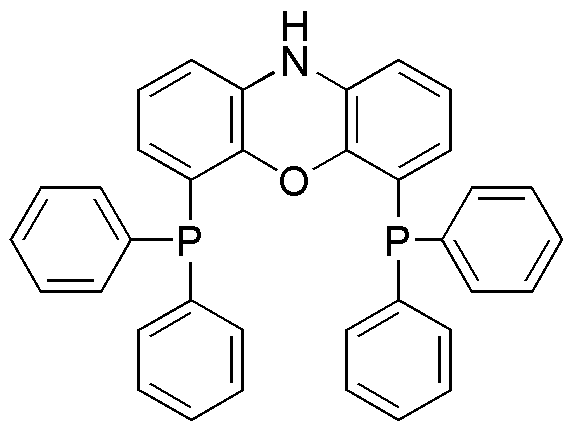4,6-Bis(diphenylphosphino)phenoxazine is widely utilized in research focused on:
- Catalysis: This compound serves as a highly effective ligand in transition metal catalysis, enhancing reaction rates and selectivity in organic synthesis.
- Pharmaceutical Development: Its unique properties allow it to be used in drug design, particularly in creating compounds that target specific biological pathways.
- Material Science: It is employed in the development of advanced materials, such as conductive polymers and organic light-emitting diodes (OLEDs), improving their efficiency and stability.
- Analytical Chemistry: The compound is utilized in various analytical techniques, including spectroscopy, to improve detection limits and accuracy in complex mixtures.
- Environmental Applications: It can be applied in the development of sensors for detecting pollutants, providing a means for monitoring environmental health effectively.
General Information
Properties
Safety and Regulations
Applications
4,6-Bis(diphenylphosphino)phenoxazine is widely utilized in research focused on:
- Catalysis: This compound serves as a highly effective ligand in transition metal catalysis, enhancing reaction rates and selectivity in organic synthesis.
- Pharmaceutical Development: Its unique properties allow it to be used in drug design, particularly in creating compounds that target specific biological pathways.
- Material Science: It is employed in the development of advanced materials, such as conductive polymers and organic light-emitting diodes (OLEDs), improving their efficiency and stability.
- Analytical Chemistry: The compound is utilized in various analytical techniques, including spectroscopy, to improve detection limits and accuracy in complex mixtures.
- Environmental Applications: It can be applied in the development of sensors for detecting pollutants, providing a means for monitoring environmental health effectively.
Documents
Safety Data Sheets (SDS)
The SDS provides comprehensive safety information on handling, storage, and disposal of the product.
Product Specification (PS)
The PS provides a comprehensive breakdown of the product’s properties, including chemical composition, physical state, purity, and storage requirements. It also details acceptable quality ranges and the product's intended applications.
Certificates of Analysis (COA)
Search for Certificates of Analysis (COA) by entering the products Lot Number. Lot and Batch Numbers can be found on a product’s label following the words ‘Lot’ or ‘Batch’.
Numéro de catalogue
Numéro de lot/série
Certificates Of Origin (COO)
This COO confirms the country where the product was manufactured, and also details the materials and components used in it and whether it is derived from natural, synthetic, or other specific sources. This certificate may be required for customs, trade, and regulatory compliance.
Numéro de catalogue
Numéro de lot/série
Safety Data Sheets (SDS)
The SDS provides comprehensive safety information on handling, storage, and disposal of the product.
DownloadProduct Specification (PS)
The PS provides a comprehensive breakdown of the product’s properties, including chemical composition, physical state, purity, and storage requirements. It also details acceptable quality ranges and the product's intended applications.
DownloadCertificates of Analysis (COA)
Search for Certificates of Analysis (COA) by entering the products Lot Number. Lot and Batch Numbers can be found on a product’s label following the words ‘Lot’ or ‘Batch’.
Numéro de catalogue
Numéro de lot/série
Certificates Of Origin (COO)
This COO confirms the country where the product was manufactured, and also details the materials and components used in it and whether it is derived from natural, synthetic, or other specific sources. This certificate may be required for customs, trade, and regulatory compliance.


